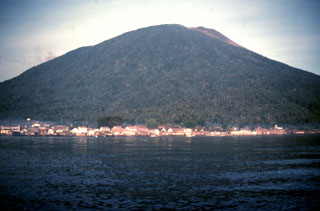Report on Gamalama (Indonesia) — July 1993
Bulletin of the Global Volcanism Network, vol. 18, no. 7 (July 1993)
Managing Editor: Edward Venzke.
Gamalama (Indonesia) Explosive ash eruptions produce columns to heights of 3,000 m
Please cite this report as:
Global Volcanism Program, 1993. Report on Gamalama (Indonesia) (Venzke, E., ed.). Bulletin of the Global Volcanism Network, 18:7. Smithsonian Institution. https://doi.org/10.5479/si.GVP.BGVN199307-268060
Gamalama
Indonesia
0.81°N, 127.3322°E; summit elev. 1714 m
All times are local (unless otherwise noted)
Ash explosions at 0600 and 0625 on 6 May produced eruption columns that rose 2,500 and 2,000 m, respectively, above the summit. There was also a small eruption at 1500 on 8 May. The strongest explosion occurred at 1338-1352 on 12 May, preceded by detonation sounds and incandescent ballistic bombs. A black ash column from this eruption rose 3,000 m and could be seen from the observatory. About 141,000 m3 of material was erupted. There was no damage caused by this eruption. An Indonesian radio broadcast also reported an eruption on 21 May (18:05). A pilot report described a smoke plume at 1000 on 17 August rising ~ 480 m above the rim before drifting NNW and dissipating.
Geological Summary. Gamalama is a near-conical stratovolcano that comprises the entire island of Ternate off the western coast of Halmahera, and is one of Indonesia's most active volcanoes. The island was a major regional center in the Portuguese and Dutch spice trade for several centuries, which contributed to the extensive documentation of activity. Three cones, progressively younger to the north, form the summit. Several maars and vents define a rift zone, parallel to the Halmahera island arc, that cuts the volcano; the S-flank Ngade maar formed after about 14,500–13,000 cal. BP (Faral et al., 2022). Eruptions, recorded frequently since the 16th century, typically originated from the summit craters, although flank eruptions have occurred in 1763, 1770, 1775, and 1962-63.
Information Contacts: W. Tjetjep, VSI; J. Lynch, SAB.

